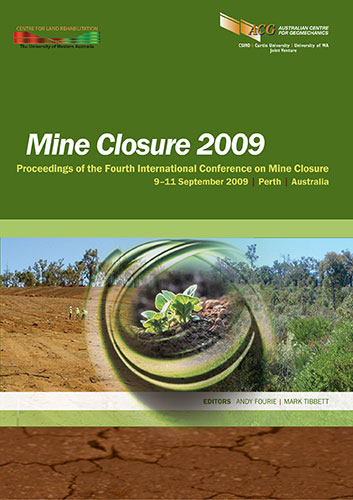Spatial variability of hydraulic properties on a bauxite residue disposal area in Western Australia

|
Authors: Gwenzi, W; Hinz, C; Phillips, I; Mullins, IJ |
DOI https://doi.org/10.36487/ACG_repo/908_39
Cite As:
Gwenzi, W, Hinz, C, Phillips, I & Mullins, IJ 2009, 'Spatial variability of hydraulic properties on a bauxite residue disposal area in Western Australia', in AB Fourie & M Tibbett (eds), Mine Closure 2009: Proceedings of the Fourth International Conference on Mine Closure, Australian Centre for Geomechanics, Perth, pp. 505-513, https://doi.org/10.36487/ACG_repo/908_39
Abstract:
Engineered cover systems based on the store-release concept are commonly used to restrict drainage into buried reactive rock wastes. In principle, store-release covers are designed to store infiltrating water, and release it slowly through evapotranspiration. A typical store-release cover should have a top layer with high water holding capacity overlying a low permeability base layer designed to act as a hydraulic barrier. The capacity of a cover system to support vegetation, which is considered a key component, depends on soil moisture availability. Hydraulic properties, in particular soil moisture retention and hydraulic conductivity, control soil moisture storage, water flux and plant available soil moisture. Accordingly, hydraulic properties are key inputs in water flow, soil-plant-atmosphere and biogeochemical models. The main objective of this study was to investigate whether a rehabilitated bauxite residue disposal area (RDA) constructed from residue sand can act as a store-release cover. To achieve this objective, Philip-Dunne and Guelph permeameters, and a constant head laboratory method were used to measure saturated hydraulic conductivity (Ks). Geostatistics was used to evaluate Ks spatial variability. Results indicate that Ks was very high (> 100 cm hr-1), but showed low spatial variability (coefficient of variation: < 45%). In general, Ks decreased from 209–400 cm hr-1 in the top 90–115 cm hr-1 at 300 cm depth. The decline was negatively correlated (r2 = 0.7) to mean dry soil bulk density (dry soil bulk density = mass of dry soil/total volume), which increased from 1313.8 kg m-3 at 15 cm to approximately 1500 kg m-3 at 300 cm depth. Correlation analysis showed that Ks for residue sand can be estimated from a simple equation based on dry soil bulk density. On the basis of the high Ks, rapid vertical movement of water is expected during rainfall events. In addition, the low water-holding capacity could lead to severe vegetation water stress particularly in the dry season. In conclusion, a cover system constructed from residue sand cannot act as a store-release cover system. It is therefore recommended that, materials with high Ks should not be used to construct a store- release cover system. To meet the objectives of a store-release cover, a redesign of the bauxite RDA is highly warranted.
References:
Arunachalam, S.K., Hinz, C. and Aylmore, G. (2004) Soil physical properties affecting root growth in rehabilitated gold
mine tailings, SuperSoil 2004: 3rd Australian New Zealand Soils Conference, 5–9 December 2004, University of
Sydney, Australia.
Benson, C.H., Bonhnoff, G.L., Apinwantragoon, P., Ogorzalek, A.S., Shackelford, C.D. and Albright, W.H. (2004)
Comparison of model predictions and field data for ET cover, Tallings Mine Waste 04, Taylor and Francis,
London, pp. 138 –142.
Blake, G.R. and Hartge, K.H. (1986) Bulk density, In Methods of Soil Analysis Part 1, A. Klute (ed), ASA Monograph
No. 9, 2nd edition. Madison, pp. 363–376.
Breshears, D.D., Nyhan, J.W. and Davenport, D.W. (2005) Ecohydrology monitoring and excavation of semiarid
landfill covers a decade after installation, Vadose Zone Journal, Vol. 4, pp. 798–810.
Buczko, U., Gerke, H.H. and Hüttl, R.F. (2001) Spatial distributions of lignite mine spoil properties for simulating 2-D
variably saturated flow and transport, Ecological Engineering, Vol. 17, pp. 103–114.
Campbell, G. (2004) Store/release covers in the Australian Outback, Mine Closure – Towards Sustainable Conference,
5–6 August 2004, Perth, Australia.
Dikinya, O., Hinz, C. and Aylmore, G. (2008) Decrease in hydraulic conductivity and particle release associated with
self-filtration in saturated columns, Geoderma, Vol. 146, pp. 192–200.
Gee, G.W. and Bauder, J.W. (1986) Particle size analysis, In Methods of Soil Analysis Part 1, A. Klute (ed), Physical
and mineralogical methods, 2nd edition, ASA SSSA, Madison, pp. 383–411.
Gόmez, J.A., Vanderlinden, K. and Nearing, M.A. (2005) Spatial variability of surface roughness and hydraulic
conductivity after disk tillage: implications for runoff variability, Journal Hydrology, Vol. 311, pp. 143–156.
Gupta, N., Rudra, R.P. and Parkin, G. (2006) Analysis of spatial variability of hydraulic conductivity at field scale,
Canadian biosystems engineering, Vol. 48, pp. 1.55–1.62.
Koch, J.M. and Samsa, G.P. (2007) Restoring Jarrah Forest Trees after Bauxite Mining in Western Australia,
Restoration Ecology, Vol. 15(4), pp. S17–S25.
Mengler, F.C., Kew, G.A., Gilkes, R.J. and Koch, J.M. (2006) Using instrumented bulldozers to map spatial variation in
the strength of regolith for bauxite mine floor rehabilitation, Soil and Tillage Research, Vol. 90, pp. 126–144.
Muñoz-Carpena, R., Regalado, C.M., Álvarez-Benedi, J. and Bartoli, F. (2002) Field evaluation of the new Philip-
Dunne permeameter for measuring saturated hydraulic conductivity, Soil Science, Vol. 167(1), pp. 9–24.
Reynolds, W.D., Elrick, D.E., Young, E.G., Amoozegar, A., Booltink, H.W.G. and Bouma, J. (2002) Saturated and
field-saturated water flow parameters, In Methods of Soil Analysis, Part 4, J.H. Dane and G.C. Topp (eds),
Physical methods, Soil Science Society of America Inc., Madison, pp. 797–878.
Wehr, J.B., So, H.B., Menzies, N.W. and Fulton, I. (2005) Hydraulic properties of layered soils influence survival of
Rhodes grass (Chloris gayana Kunth.) during water stress, Plant and Soil, Vol. 270, pp. 287–297.
Wösten, J.H.M., Pachepsky, Y.M. and Rawls, W.J. (2001) Pedotransfer functions: bridging the gap between available
basis soil data and missing soil hydraulic characteristics, Journal of Hydrology, Vol. 251, pp. 123–150.
© Copyright 2026, Australian Centre for Geomechanics (ACG), The University of Western Australia. All rights reserved.
View copyright/legal information
Please direct any queries or error reports to repository-acg@uwa.edu.au
View copyright/legal information
Please direct any queries or error reports to repository-acg@uwa.edu.au